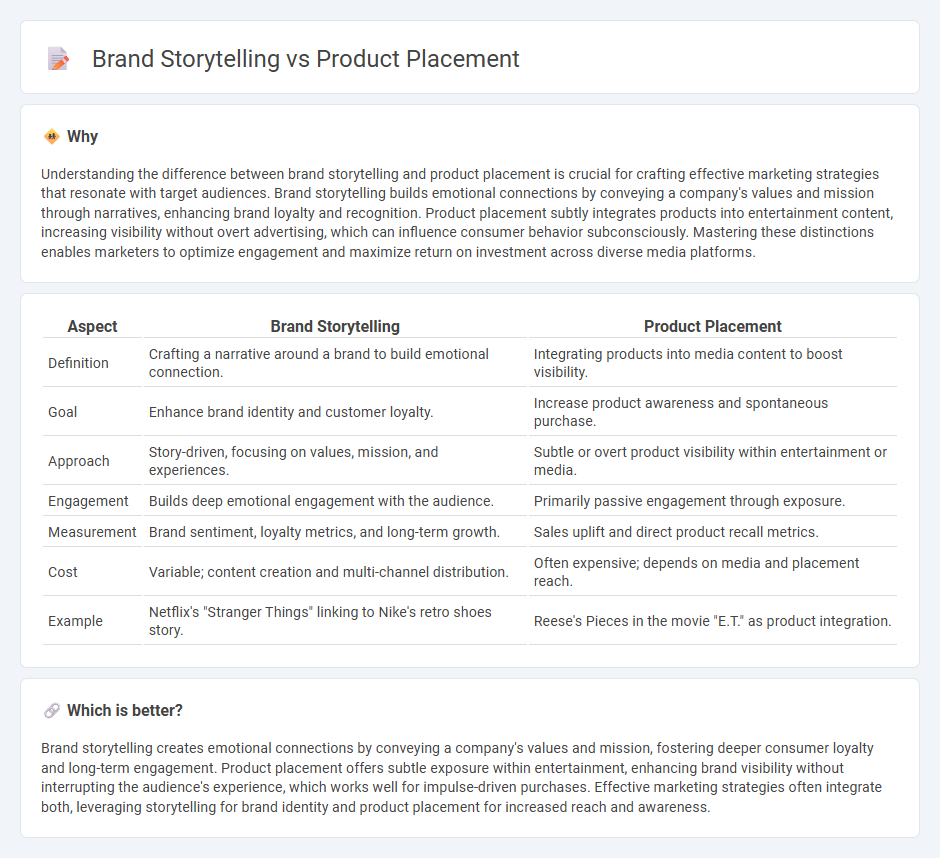
Brand storytelling creates emotional connections by weaving narratives that highlight a company's values and mission, fostering long-term customer loyalty. Product placement integrates products seamlessly into entertainment content, enhancing visibility and influencing consumer behavior subtly. Discover how each strategy can elevate your marketing efforts effectively.
Why it is important
Understanding the difference between brand storytelling and product placement is crucial for crafting effective marketing strategies that resonate with target audiences. Brand storytelling builds emotional connections by conveying a company's values and mission through narratives, enhancing brand loyalty and recognition. Product placement subtly integrates products into entertainment content, increasing visibility without overt advertising, which can influence consumer behavior subconsciously. Mastering these distinctions enables marketers to optimize engagement and maximize return on investment across diverse media platforms.
Comparison Table
| Aspect | Brand Storytelling | Product Placement |
|---|---|---|
| Definition | Crafting a narrative around a brand to build emotional connection. | Integrating products into media content to boost visibility. |
| Goal | Enhance brand identity and customer loyalty. | Increase product awareness and spontaneous purchase. |
| Approach | Story-driven, focusing on values, mission, and experiences. | Subtle or overt product visibility within entertainment or media. |
| Engagement | Builds deep emotional engagement with the audience. | Primarily passive engagement through exposure. |
| Measurement | Brand sentiment, loyalty metrics, and long-term growth. | Sales uplift and direct product recall metrics. |
| Cost | Variable; content creation and multi-channel distribution. | Often expensive; depends on media and placement reach. |
| Example | Netflix's "Stranger Things" linking to Nike's retro shoes story. | Reese's Pieces in the movie "E.T." as product integration. |
Which is better?
Brand storytelling creates emotional connections by conveying a company's values and mission, fostering deeper consumer loyalty and long-term engagement. Product placement offers subtle exposure within entertainment, enhancing brand visibility without interrupting the audience's experience, which works well for impulse-driven purchases. Effective marketing strategies often integrate both, leveraging storytelling for brand identity and product placement for increased reach and awareness.
Connection
Brand storytelling and product placement intersect by creating immersive narratives that seamlessly integrate products into engaging stories, enhancing consumer emotional connection and brand recall. Effective product placement leverages storytelling techniques to position products within relevant contexts, making the marketing message more authentic and memorable. This synergy boosts brand visibility and influences purchasing decisions by embedding the product naturally within the consumer's experience.
Key Terms
**Product Placement:**
Product placement integrates branded products seamlessly into movies, TV shows, and digital content to enhance brand visibility and recall without disrupting the viewer's experience. This marketing strategy leverages contextual alignment with audience preferences to boost subconscious brand recognition and drive consumer behavior effectively. Explore how strategic product placement can transform your brand exposure and engagement.
Integration
Product placement integrates brands organically within entertainment content, enhancing audience recall without disrupting narrative flow. Brand storytelling weaves a compelling narrative around the brand's values, creating emotional connections that drive long-term loyalty. Explore how strategic integration of these approaches can amplify marketing impact and engage consumers more effectively.
Subtlety
Product placement thrives on subtle integration of brands within content, enhancing consumer perception without overt advertising. Brand storytelling weaves a narrative around the brand's values and identity, creating emotional connections that resonate deeply with audiences. Discover how mastering subtlety in these strategies can elevate brand engagement and authenticity.
Source and External Links
What Is Product Placement? Definition and Examples | Indeed.com - Product placement is an advertising technique that promotes specific brands and products naturally through media like movies or retail displays, such as placing products at eye level or near checkout counters to boost sales.
Product Placement: Examples and Business Benefits (2025) - Shopify - Product placement involves intentionally inserting products into non-advertising content like films or video games, ideally done with transparency, relevance to the storyline, and to enhance viewer experience without overt advertising.
Product placement - Wikipedia - Product placement, or embedded marketing, integrates brand references into works such as films or TV shows in exchange for compensation, ranging from subtle appearances to prominent features, and is a growing industry worth billions in modern media.
 dowidth.com
dowidth.com